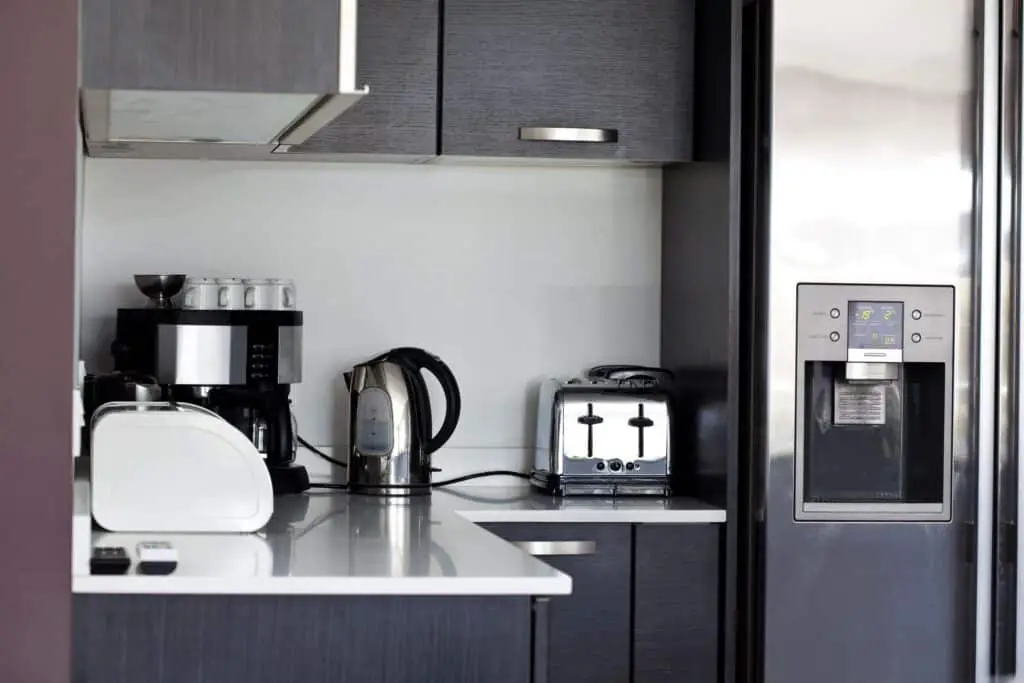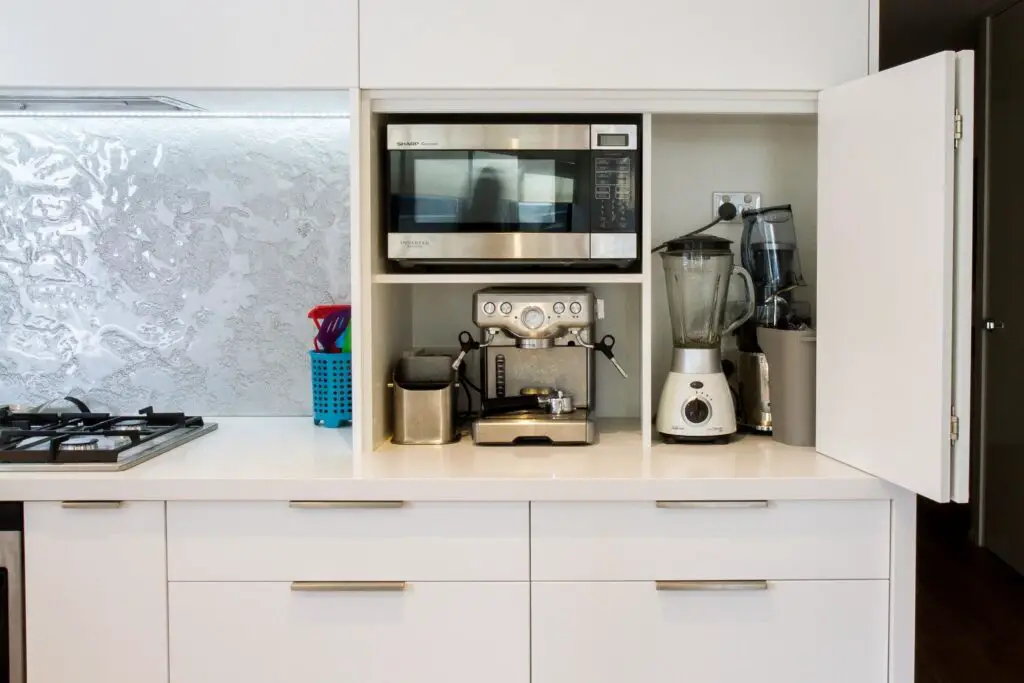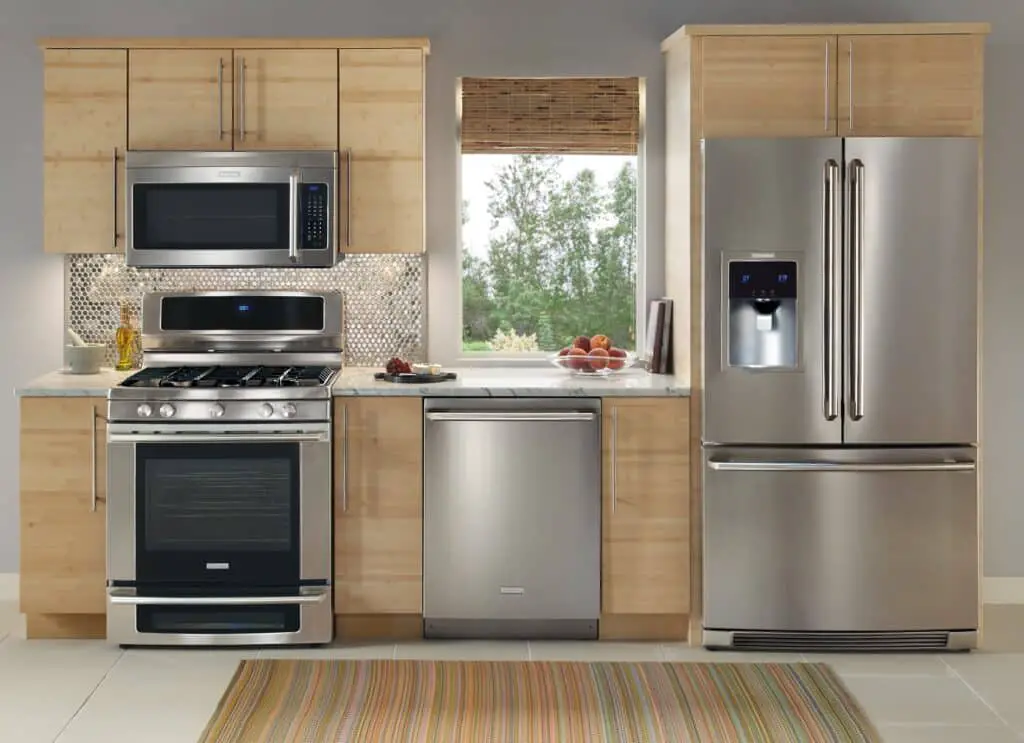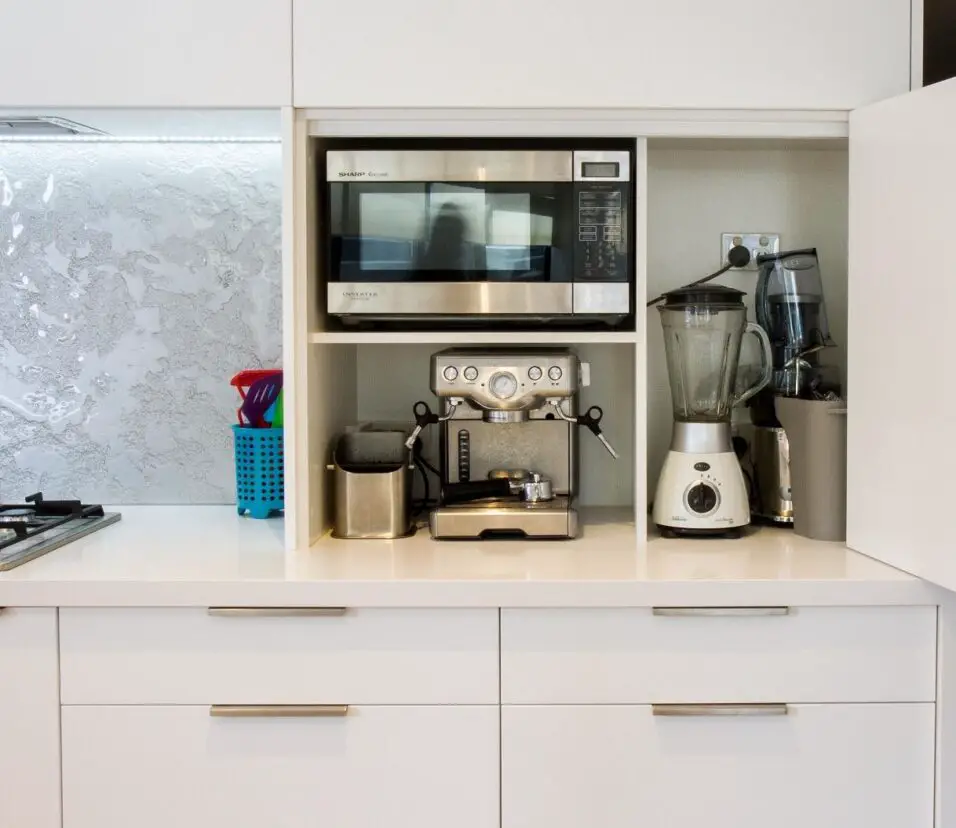How To Arrange Appliances In Small Kitchen
Introduction
How To Arrange Appliances In Small Kitchen: Designing an effective layout for a small kitchen requires thoughtful consideration of both functionality and aesthetics. The key is to strike a balance between creating a seamless workflow and maximizing the available space. In this guide, we will explore some practical tips and tricks to help you arrange your appliances in a way that not only enhances your culinary experience but also transforms your compact kitchen designer into a harmonious and inviting space.
Begin by making a list of essential appliances that you use regularly. Prioritize those that are essential for your cooking routine. In a small kitchen, vertical space is your best friend. Install wall-mounted shelves, hooks, or magnetic strips to hold smaller appliances, cooking utensils, and even pots and pans. This will free up valuable counter space and keep everything within easy reach.
Look for appliances that serve multiple purposes or come in compact sizes. For instance, you can opt for a combination microwave and convection oven, a toaster oven that can handle various tasks, or even a space-saving refrigerator designed for smaller kitchens. Organize your appliances by categories. For example, keep all the coffee-related appliances together, like the coffee maker, grinder, and mugs. Grouping similar items not only keeps your kitchen organized but also streamlines your cooking process.

How do I arrange my kitchen appliances?
How to organize kitchen appliances
- Keep appliances in categories.
- Choose the shelf based on frequency of use.
- Keep heavy appliances on the lowest shelves.
- Only keep the absolute essentials on counters.
- Keep wires wrapped up and neat.
- Don’t hold onto appliances you don’t use regularly.
- Get rid of paper manuals.
Make a list of your essential kitchen appliances based on your cooking habits and lifestyle. Common essentials include a stove, refrigerator, dishwasher, microwave, and a coffee maker. Prioritize these appliances as they will have a fixed location in your kitchen layout.
Divide your kitchen into functional zones based on tasks such as cooking, cleaning, and food storage. This zoning approach will help you organize your appliances based on their purpose and streamline your workflow. Keep cooking appliances near the stove, cleaning appliances near the sink, and food storage appliances close to the refrigerator.
Prioritize these appliances as they will have a fixed location in your kitchen layout.
The work triangle consists of the sink, stove, and refrigerator, which are the three most frequently used areas in the kitchen. Arrange these elements to form an efficient work triangle, ensuring that they are not too far apart to minimize unnecessary movement during cooking.
Place appliances near electrical outlets to avoid using extension cords, which can be both unsightly and hazardous. If needed, consider adding additional outlets in convenient locations to accommodate your appliance arrangement.
Maximize storage by utilizing vertical space. Install wall-mounted shelves, hooks, or a magnetic strip for holding smaller appliances, cooking utensils, and pots. This will free up valuable counter space and keep your kitchen organized.
Group similar appliances together based on their function. For instance, keep all your coffee-related appliances in one area, including the coffee maker, grinder, and mugs. This organization makes it easier to locate what you need and enhances efficiency.
Appliance garages are clever cabinets designed to hide small appliances when not in use, keeping your counters clutter-free. Consider installing one to maintain a tidy appearance in your kitchen.
Incorporate pull-out or slide-in elements for certain appliances, such as the microwave or a cutting board. These solutions help to keep appliances out of sight when not needed, preserving a clean and visually appealing kitchen.
Where should a fridge be placed in a small kitchen?
Keeping the fridge in a corner allows you to grab what you need, then move into the center of the kitchen for prep and cooking. Make sure to leave enough room to fully open doors if placing one side against the wall. Near a countertop or bench.
The work triangle in a kitchen consists of the sink, stove, and refrigerator – the three areas most frequently used during meal preparation. In a small kitchen, it’s crucial to place the fridge close to the work triangle to minimize unnecessary movement and create a smooth cooking workflow. Ideally, the fridge should be within easy reach of the other key areas to facilitate efficient food storage and retrieval.
When selecting a spot for your fridge, take into account the direction in which the door swings. Make sure the fridge door doesn’t block any other kitchen elements, such as cabinets or the kitchen entrance. Additionally, allow sufficient clearance for the fridge door to open fully without any obstruction.
In a small kitchen, every inch of space counts. Look for unused or underutilized areas where the fridge can fit without disrupting the flow of the kitchen. Consider narrow spaces between cabinets, the end of a counter, or even a recessed nook if available.
To maximize space efficiency, consider creating an alcove or enclosure for the fridge. This can involve installing cabinets or open shelving around the fridge, effectively integrating it into the kitchen design while also providing additional storage for pantry items or cookware.
In small kitchens, standard-sized fridges may protrude too far into the kitchen space, disrupting the flow and taking up valuable room.Tall and narrow refrigerators can be a practical solution for small kitchens as they utilize vertical space while maintaining a small footprint.
How do I keep my oven in a small kitchen?
The counter or the platform area:
Small sized microwave can easily be placed in a corner on the counter or the kitchen platform. Never place the oven near the sink or gas stove but look for an ideal corner that might be near to the refrigerator since it is good for convenience.
Start by assessing your kitchen layout and identifying potential spots for the oven. Measure the available space to determine the dimensions that the oven can comfortably fit into. Consider both floor space and vertical space, as wall-mounted ovens or oven towers can be great space-saving options.
Decide whether a freestanding or built-in oven would be more suitable for your small kitchen. Freestanding ovens are self-contained units that can be placed anywhere with appropriate clearance. Built-in ovens, on the other hand, are integrated into cabinetry and can save valuable floor space.
In a small kitchen, it’s essential to utilize vertical space effectively. If you have limited floor space, consider wall-mounting the oven. Wall ovens are typically placed at waist or eye level, making it easier to access and reducing the need to bend down.
If you have a compact kitchen, under-counter ovens are a practical solution. These ovens fit beneath countertops, maximizing available space and blending seamlessly with the overall kitchen design.
Look for compact ovens that still offer essential features and functionalities. There are many space-saving options available on the market, including slimline ovens and combination microwave-ovens, which can perform multiple tasks within a small footprint.
How do you manage things in a small kitchen?
- Install Pull-Down Shelves. Hulya Kolabas.
- Cut Down on Duplicate Items. Magnet Kitchens.
- Stock Shelves With Essentials. Stacy Zarin Goldberg.
- Label Food Storage Canisters. A Beautiful Mess.
- Add Shelves in the Cupboard.
- Build in Kitchen Island Storage.
- Give Everything a Place in the Fridge.
- Hide Pantry Items in Baskets.
Identify the essential kitchen items you use frequently and prioritize their storage. Focus on keeping the most important tools and appliances readily accessible, while less frequently used items can be stored in less accessible spots.
Utilize vertical space by installing shelves, hooks, and magnetic strips on walls and inside cabinets. These additions can hold smaller appliances, cooking utensils, and pots, freeing up counter space.
Consider space-saving appliances that offer multiple functions or compact designs. Combination microwave-ovens, slimline dishwashers, and under-counter fridges are excellent options for small kitchens.
Organize your kitchen by grouping similar items together. Keep baking supplies, pots, and pans, or coffee-related items in designated areas. This arrangement streamlines your cooking process and makes it easier to find what you need.
Drawer organizers can be a game-changer in small kitchens. They keep utensils and small items neatly separated, maximizing drawer space and making everything easily accessible.

How do you arrange a microwave in a small kitchen?
Installed Above the Counter
- Over the Range. Placing your microwave ‘over the range’ means that you have installed it above the countertop or over a range.
- Integrated with the Cabinetry. Microwaves can be integrated with the cabinets of your home to save on counter space.
- Combined with a Wall Oven.
Maximize vertical space by installing a microwave shelf or mounting the microwave under cabinets. Wall-mounted microwaves not only free up precious counter space but also provide a streamlined look in a small kitchen.
Built-in microwaves or microwave drawers can be excellent choices for small kitchens. These options seamlessly integrate into cabinetry, saving valuable space while offering a sleek and modern appearance.
If you prefer keeping the microwave on the counter, consider using an appliance garage or a microwave cart. An appliance garage is a cabinet with a retractable door that hides the microwave when not in use, keeping the countertop neat and clutter-free. A microwave cart provides mobility, allowing you to move the microwave to different locations as needed.
If your kitchen has a pantry or tall cabinets, consider adding a microwave shelf inside one of them. Placing the microwave in a pantry or cabinet can free up counter space and keep the appliance easily accessible without taking up valuable room.
If you have a compact kitchen with limited counter space, you can consider installing a microwave above the stove. Many microwaves come with venting capabilities, which can also serve as an exhaust fan for your cooktop.
If you’re planning a kitchen remodel or renovation, consider creating a dedicated microwave niche or alcove. This custom-designed space can be a perfect fit for your microwave and provide a seamless look with the rest of your kitchen.
Where should a microwave be placed in a small kitchen apartment?
Trudi most often suggests putting the microwave under the counter, often on the end of the island to free up space in upper kitchen cabinets. Building your microwave into the cabinetry below your countertop means it’s at a great height for kids warming up snacks and keeps it out of the main kitchen flow.
One of the most common and convenient locations for a microwave in a small kitchen apartment is on the countertop. It allows easy access for reheating or cooking, making it a practical choice for daily use. Ensure there is ample counter space available and consider using a microwave cart or appliance garage to keep the countertop neat and clutter-free when the microwave is not in use.
If your counter space is limited, consider mounting the microwave under the upper cabinets. This space-saving solution not only keeps the microwave within easy reach but also frees up valuable counter space for food preparation.
Under-cabinet mounting can create a sleek and streamlined look in your small kitchen.
For a seamless and integrated look, consider a built-in microwave or a microwave drawer. These options can be installed into cabinetry or kitchen islands, preserving valuable floor and counter space. Microwave drawers, in particular, offer accessibility without bending down and can be an excellent addition to lower cabinets or kitchen islands.
If you have limited counter space, an above-the-stove microwave can be a space-saving solution. Many microwaves come with venting capabilities, functioning as an exhaust fan for your stove as well. However, ensure the height of the stove and microwave suits your needs and provides comfortable access.
If your kitchen apartment has a pantry or tall cabinets, consider adding a microwave shelf inside one of them. Placing the microwave in a pantry or cabinet can free up counter space and keep the appliance easily accessible without taking up valuable room.
Where should small appliances be stored?
A corner cabinet, with or without a built-in lazy Susan, is the ideal spot for storing appliances. Bremer notes that its odd, cavernous depth is perfect for these bulky, awkward-shaped tools. Make the swap, and you’ll see how convenient it is to have everything stored in one place.
Consider installing pull-out shelves or drawers in your cabinets to make retrieving and storing small appliances more convenient. These additions allow you to access the appliances without having to reach deep into the cabinet.
Displaying small appliances on open shelves or wall-mounted racks can be a stylish and practical solution, especially for frequently used items like coffee makers or toaster ovens. This not only keeps them within easy reach but also adds a decorative element to your kitchen.
Appliance garages are dedicated cabinets with roll-up or flip-up doors designed to conceal small appliances while keeping them easily accessible. These are excellent options to keep your countertop neat and organized.
Make use of the space underneath upper cabinets to store smaller appliances like microwaves or coffee makers. Installing under-cabinet shelves or brackets can provide a designated spot for these items without taking up valuable counter space.
If you have a pantry, allocate a section or install pull-out shelves specifically for storing small appliances like toasters, blenders, or juicers. This ensures they have their designated space and are separate from food items.
If your kitchen has an island, consider incorporating storage solutions within it. Drawers or cabinets can be designed to accommodate small appliances, keeping them close at hand during meal preparation.
What comes under small appliances?
Examples include microwave ovens, kettles, toasters, humidifiers, food processors and coffeemakers. They contrast with major appliances (known as “white goods” in the UK), such as the refrigerators and washing machines, which cannot be easily moved and are generally placed on the floor.
Mobile carts or trolleys with shelves can be a versatile storage option for small appliances. You can move them around the kitchen as needed, making it easy to access appliances when cooking and stow them away when not in use.
Maximize corner cabinet space by using turntables or lazy Susans. These revolving platforms allow you to access small appliances stored in the back of the cabinet without having to reach or rummage through the contents.
If you have unused wall space in your kitchen, consider installing shelves or hooks to hang smaller appliances. This solution can free up cabinet space and add a functional and decorative touch to your kitchen.
For smaller appliances that you use frequently, consider incorporating them into your kitchen’s functional display. For example, if you make smoothies often, store the blender on the counter near the refrigerator for easy access.
Utilize cabinets, cupboards, and pull-out shelves for less frequently used appliances. Display frequently used items on open shelves or wall-mounted racks for easy access. Consider appliance garages or under-cabinet spaces to keep your countertops clutter-free.
Pantry storage, island storage, and mobile carts are additional options to consider based on your kitchen layout and needs. Utilize unused wall space and corner cabinets effectively, and incorporate functional display to optimize the storage of small appliances.

Conclusion
Start by identifying your essential appliances and prioritize them according to your cooking routine. Utilize vertical space with wall-mounted shelves, hooks, and magnetic strips to free up valuable counter space. Look for compact and multi-functional appliances to maximize efficiency without sacrificing functionality. Consider pull-out or slide-in solutions for certain appliances to maintain a clean and clutter-free appearance when not in use. Group similar items together to streamline your cooking process and maintain order in the kitchen. Explore under-cabinet appliances and rolling arrange kitchen carts to add flexibility and convenience to your setup.
Pay attention to the work triangle – the relationship between the sink, stove, and refrigerator – to minimize unnecessary steps while cooking. Install appliance garages to keep small appliances out of sight when not needed and maintain a tidy appearance. Throughout the process, prioritize safety and ensure that your appliance arrangement doesn’t impede movement or create hazards in the kitchen.
Remember, a small kitchen can be just as functional and inviting as a larger one with the right organization and design. Embrace the challenge of limited space, get creative, and tailor the arrangement to suit your unique needs and cooking style. Arranging appliances in a small kitchen requires careful thought, creativity, and a focus on optimizing every inch of available space. By strategically organizing your appliances, you can transform your compact kitchen into a highly functional and visually appealing cooking haven.




